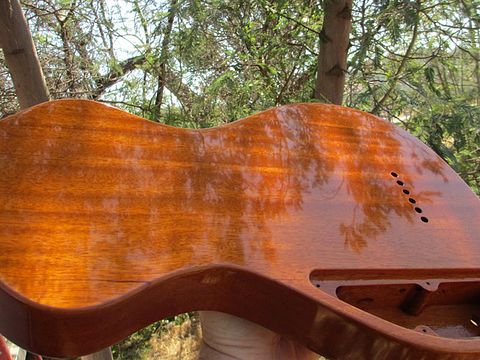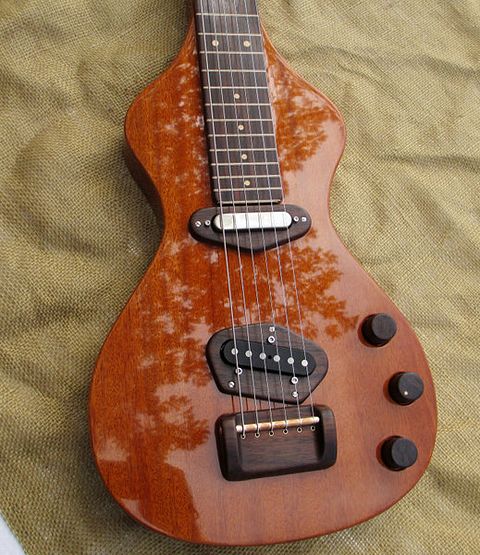Hello Frets.net,I'm new here and just wanted to say thank you to everyone who's contributed, I've found some very invaluable information on this site that has helped me tremendously along the way.
With that being said, I'd like to get people's opinion: Which finish is more durable, TruOil (Birchwood Casey) or Wipe-On Poly (e.g. Minwax)? Every tech sheet I've read says that TruOil is not really durable at all, and is more on the oil category such as lemon and linseed. Whereas, wipe-on poly is known for durability. However, people on some forums have claimed that they won't use anything else besides TruOil due to it's protection and feel.
Some I'm stumped, but looking for a more durable finish against dings, bumps, as well as humidity. Can you help? Thanks!
Tags: durability, finish, truoil, wipe-on-poly
Views: 12460
Replies to This Discussion
-
Hello everyone and thanks again for all the replies. I posted this link in an earlier post showing the process in which I used Z-Poxy and the Minwax wipe-on poly to some good success: Refinishing Thread: Curly Koa Ukulele (Z-Poxy/Minwax Wipe-On Poly). Based on my experience, the resulting finish has a very durable feel to it. The reason I'm considering TruOil is because of the application process. As mentioned before as well, I don't have the means to a spray booth setup, so I'm restricted to either a brush or wipe-on application method. The problem with the wipe-on poly is that you have a very short working time. Once you wipe it on, you don't have much ability to fix or improve the wipe streaks. Any subsequent wipes produce a type of haze or cloudiness as the poly has already began it's drying/curing process once its applied.
In contrast to the experience I've described above, if you view this video of an application method of TruOil, you'll see that there is a very extended working time: Dave Bagwill demonstrates Tru-Oil Application. You'll notice that after he applies the TruOil, he goes over it several times with a clean paper towel to correct/improve any wiping streaks.
With both of these contrasts of application working time explained, I was made aware by another on a different forum that the "very durable feel" of the Z-Poxy/Minwax wipe-on poly combination that I am experiencing is probably mostly coming from the base/foundation layer of Z-Poxy and not the wipe-on poly itself.
Now I have the following questions and would greatly appreciate anyone's thoughts:
- Is this true, is the "durability" I feel in the finish really coming from the Z-Poxy and not the poly?
- I'll be pore-filling the next instrument refinishing with Z-Poxy, is it okay to use TruOil on top of Z-Poxy?
- Do you think that I could obtain the same "durability" feel with TruOil over Z-Poxy that I have with the wipe-on poly over Z-Poxy?
If this notion of "durability" truly does come from the Z-Poxy base and not the poly, then I think I'd like to attempt the TruOil method - but this is what I don't have enough knowledge or experience to decide. I'll leave with some pictures I found that has some really nice pictures of TruOil that has been brought up to a high-gloss, so I guess it really is possible. These are not my photos and can be found on this thread: How do you get a high-gloss from Tru-oil finish?
-
Well, not having used tru oil myself, but having used heat treated tung oil, which I believe has a bery similar if not identical application method, Ill try and point you in the general direction. I dont have all the answers though so bear this in mind and continue your research. Maybe try to contact the person responsible for the instrument pictured?
When tung oil is applied to bare wood, you can sand up to pretty well any grit youd like. Theres not much point in going past 320 (this could be debatable), but it will stick to very smooth surfaces pretty tenaciously. Ive applied tung oil with a polished scraper beside the project and got a few drops on them accidentally. I left it there thinking itd come off no problem, but that was incorrect, and said drops remained until the next polishing session for that scraper - even then, it took a bit of elbow grease to remove. So, since youd be applying over the z poxy, id sand that with 320. I believe you want to avoid going though to the wood with that stuff.
To apply the tung oil, you simply dip a clean, preferably dust free cloth in a puddle of it, and generously wipe it on the workpiece, watching for areas where it absorbs quickly and applying more there as necessary. You then let the stuff sit for a few minutes, and buff off the excess. Probably by the time you finish wiping it on a guitar, the other end, where you began, will be more than ready to buff off. If the oil is too sticky to buff, simply re wet it with fresh oil and buff immediately. Applied over a surface thats already sealed with z poxy, you shouldnt need very much oil compared to bare wood.
Subsequent coats will require less and less oil. To form a build, and thereby a gloss, you simply repeat this process once every day or two until you have achieved the thickness and sheen that is desired. You may need to rub the piece down with steel wool or fine sandpaper or the like to remove imperfections.
I have never polished an oil finished piece to a full gloss, so Im not positive if there are any pitfalls to using the methods that would be conventional with lacquer. This should be pretty easy to find out with some test pieces though.
Regarding the durability of you z poxy/poly finish, I doubt that the toughness you noted is solely the result of the z poxy, but its surely contributing to it. As to whether its compatible or not, it should be, as once the z poxy cures youll be left an inert solid coat that the oil shouldnt react with.
Youll certainly want to do some test pieces to be sure about compatibility, and to determine the durability and adhesion compared to the wiped poly a good way to test durability/adhesion is to use a razor to cut a crosshatch pattern into the finish, stick tape down over this, and see what comes up when you remove it. Start with weaker tapes and progress until you pull up chunks. If you compare both finishes this way, youll see which fails first.
Also, others have stated that oil wont seal very well against moisture exchange and therefore have an impact on instrument stability. The z poxy sealer should go a long way toward rectifying this.
Hopefully this is helpful to you joe. Happy testing!
-
Peter, I think you misunderstand me but I also think we have drifted far from the intent of this thread and should allow it to return to is's regularly scheduled programming.
My apologies to you, JoeGuam, for my part in what turned into a hijacking of your thread. Thank you for your tolerance.
I'm looking forward to seeing what you decide to do. I've though for some time that I should try Tru Oil for myself but I keep putting it off because it always seems that I have a batch of shellac that needs to be used up. I've worked with Poly in various forms and application methods quite a bit. Personally, I like the gloss but I struggle with keeping it as thin as like my final finish to be, particularly when I've applied it by hand rather than spraying.
I have done some experimenting with doing French Polish using lacquers other than Shellac with mixed results. Some of the tests worked fairly well but I had some issues with getting a clean final coat that I haven't been able to resolve. Inquires continue. ( For those of you who know, Yes, I've been reading Pratchett's "Guard" books again! )
- ‹ Previous
- 1
- 2
- 3
- Next ›
© 2025 Created by Frank Ford.
Powered by
![]()

